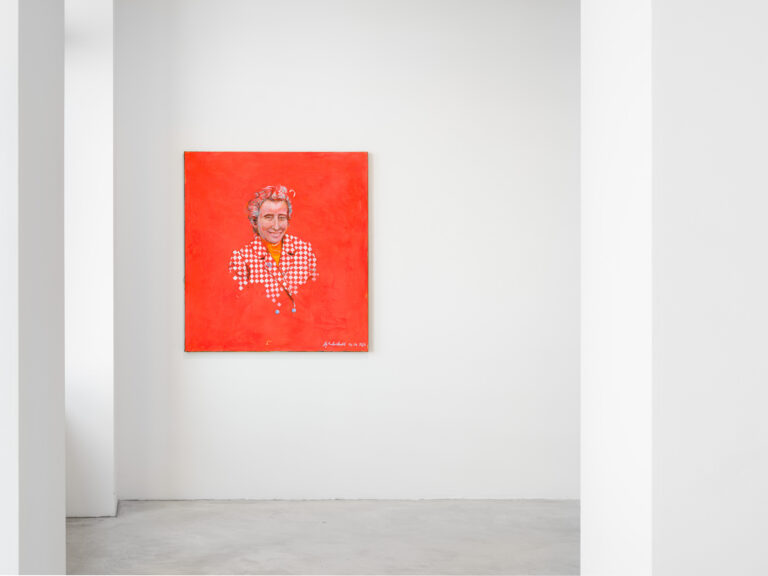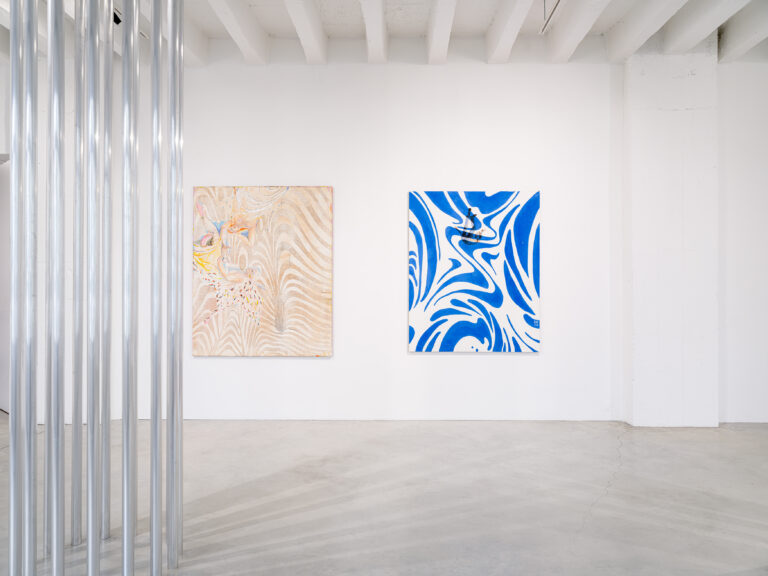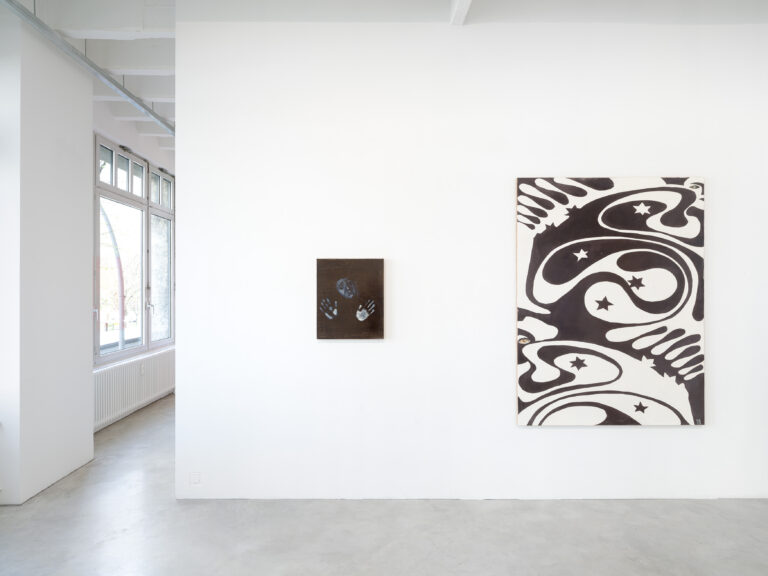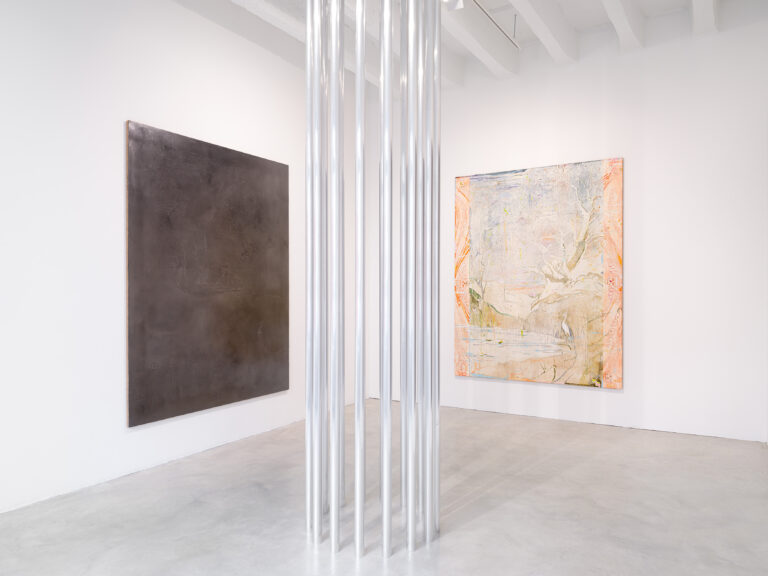Sophie Reinhold
TRÄUM WEITER
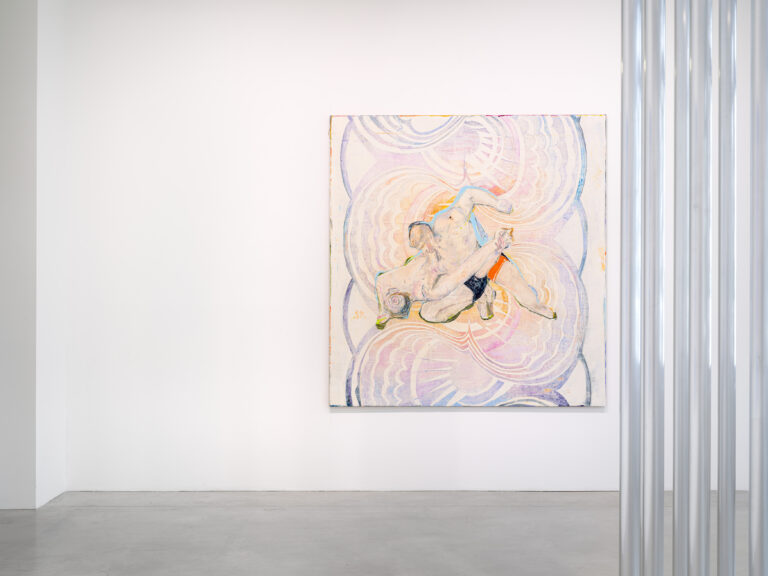
Sophie Reinhold, Installation view at Galerie Nordenhake during Gallery Weekend Berlin, Photo: Gerhard Kassner
Sophie Reinhold thematises questions around dreams and lies, simulation and real life in her first solo exhibition with Galerie Nordenhake in Berlin. The exhibition juxtaposes a site-specific installation with new paintings made specifically for the show, executed on surfaces prepared with bitumen, ground marble and graphite powder. The installation comprises four identical sculptures made from 16 aluminium pipes arranged in a hollow circle, which traverse the ceiling height and disrupt the line of sight. Resuming the architecture, they constrain or widen the perspective of the paintings dependent on the room. As the viewer climbs the once opulently decorated staircase to the gallery, they encounter the first sculpture, placed in front of the gallery. The clash between the sculpture as a symbol of architectural representation of power and its yet seemingly out of place industrial aesthetic, anticipates the interpretation of the paintings within the gallery space.
The artist’s imagery often speaks to classical iconography and mythology, which is underlined by the sculptural quality of the paintings that breaks with a satirical depiction of ubiquitous images. This break allows the viewer to become aware of the technical process in which the artist stretches jute over a panel and then applies layers of marble or graphite powder – at times dyed with pigments. The result is sanded down to a fetishist smoothness, parts of which are carved to create figurative reliefs. Bare textile revealed in the process irritates the seductive illusion of perfection. The appearance of an image and what stands behind it, is a recurring question in the artists’ practice. Her technique, aided by her painting skills, and a twisted sense of humour, open room for discourse.
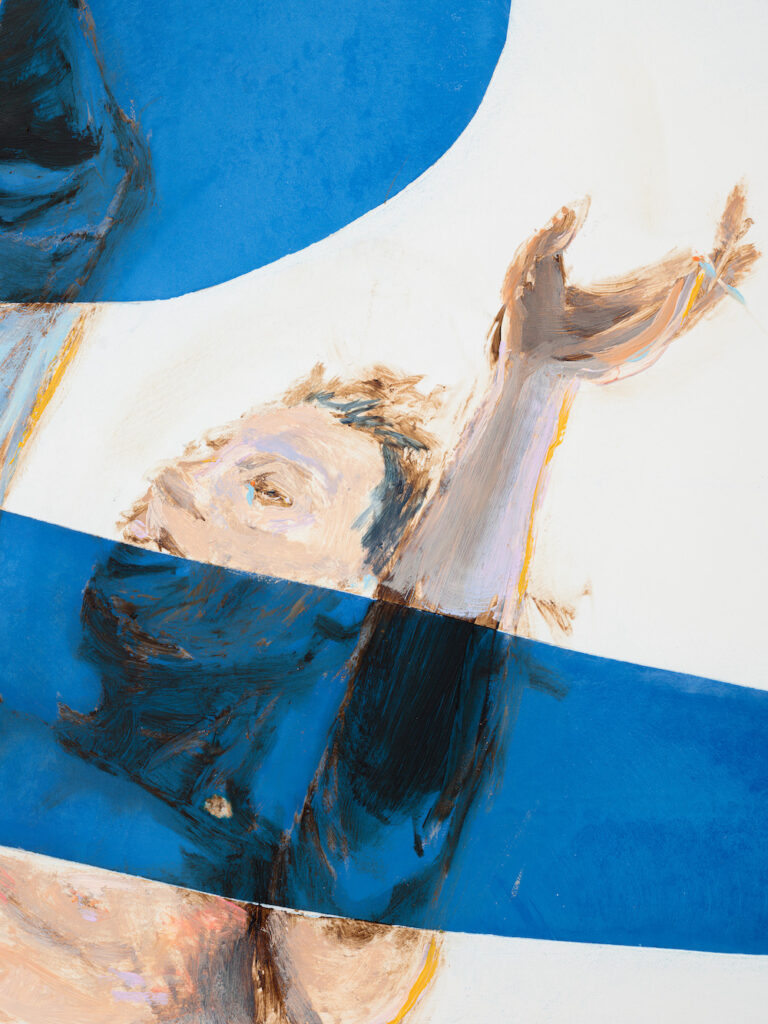
“The coated, fetishistic superficiality in the art of Sophie Reinhold engages a political agency built on a powerful sense of carnivalesque joy and hope.”
Paolo Baggi Sophie Reinhold: don’t get used to it, in Conceptual Fine Arts, January 11, 2023
Reinhold critically processes her every day, questioning what roles conflict, illusion and lies play. Guided by preposterous contradictions, such as the depiction of wrestlers1 against an almost psychedelic, ornamental background with celestial motifs, the artist investigates the performativity of a conflict as something productive rather than aggressive. The main gallery room holds two sculptures, that widen the space and reveal three more large paintings through the view of them. A relief depicts two levitated, embracing figures, that seem to be entangled into the canvas built from pigmented marble. It is framed by two paintings similar in their ornamental background, however their smoothness obscures the depiction of watching eyes on one side and a falling body on the other. The moment just before awakening perhaps. In the smaller gallery room, a fourth sculpture enclosed by three larger paintings, creates a sense of density. Once passed, the viewer’s reflection is captured in a void of two paintings made of bitumen and graphite. It allures into a doomed fantasy of the third painting: a relief prepared with ground marble, which pictures an idyllic landscape framed by a colourful frieze with skulls. Upon leaving this room an aftertaste of the exhibition title lingers in the back of the mind: träum weiter, dream on.
Spiked with symbols from the past, Reinhold’s motifs come together heterogeneously, which speaks to their very nature that facilitates a humorous rethinking of representative strategies. The insistence on inconsistency, almost as a form of protest, makes way for a process of dissociation when viewing the work. It unfetters questions to new possibilities instead of simulating pre-existing thoughts. The past is not negotiated as something static, instead, it grows nurtured by discourse in an uncontrollable way. Images lie but stripped leave truth.
Sophie Reinhold was born in Berlin in 1981, and currently lives and works in Berlin. Recently she has had solo exhibitions at Fitzpatrick Gallery, Paris, Philipp Zollinger, Zurich (both 2022), Galerie Sophie Tappeiner (2021), Sundogs, Paris and Kunstverein Reutlingen (both 2019) with Ruth Wolf-Rehfeldt. Reinhold‘s works have been on view in group exhibitions at Kunsthaus Graz and Fri Art Kunsthalle Fribourg (both 2022), Neue Gesellschaft bildende Kunst, Berlin (2021), Kunstverein Ingolstadt and n.b.k., Berlin (both 2019). She is the recipient of the Villa Romana Prize (2012) and was shortlisted for the Max-Pechstein-Prize 2013, as well as the Columbus Art Foundation-Prize of Kunsthalle Ravensburg (2012).
Exhibition Text by Elisa R. Linn
Plato was not only a ‘broad-shouldered’ aristocrat, as his philosophical foster father called him, but a fighter who flexed his muscles at the Isthmian show wrestling. In his dialogue Laws, he praised the advantages of wrestling to young people. After all: this would nurture character through physical virtues, courage, and endurance, and in ethical competition harbours a true promise of autonomy in democracy. Träum weiter.
That the corporal-based dialectic of wrestling as a complexity-reduced construction of meaning is essentially “only” an exaggerated simulation of basic mythical patterns is something we have recently learned again at the Volkstheater: ‘In 1938, newspapers in North America stopped reporting on wrestling events because it was discovered that the whole thing was a fake – and that the outcome of the competitions was predetermined’. While that melodramatic display of competition, rivalry, and animosity – the so-called kayfabe – still amounts to a life support for reality as ‘real’ and ‘true’ today, the audience surrenders to the power of ‘the perfection of iconography’ as if in a ‘suburban cinema’ – the Molière-esque pain of a rundown Mickey Rourke. This martyr to capitalist cruelty and the cosmic sins of an immoral world climbs to the top rope of the ring to deliver his signature finishing move, the Ram-Jam headbutt, to the crowd. Crowd-pleasing as it lives and breathes. Unlike boxing, the audience doesn’t crave the authentic knockout. No, it doesn’t demand the passion itself, but rather its representation as cheap showmanship.
Instead, the masses cling to the immanent justice of a longed-for strike by the hero against the unstable character of the villain, the so-called ‘bastard’. The bastard takes ‘refuge behind the law when he considers that it is in his favour, and breaks it when he finds it useful to do so’ (Roland Barthes). It is not the betrayal of the law that offends the audience, but when the visible ‘rigorous reckoning of compensations’ is disturbed, when the deserved punishment of the villain fails to materialise in the semiotics of the show ring. What the audience – the (once Athenian) citizens – represent here outside the ring is not the inevitable pressure, the shamefulness, or the dichotomy of a lie. It is the willingness to be guided by ignorance, opinion (rather than fact) and a susceptibility to images. Plato’s lived ring philosophy sketches a utopian form of government that favours justice over truth and tolerates ‘noble lies’ – lies that are meant to support the shaky pillars of common life (the polis). Träum weiter.
Plato’s intellectual adversary, Hannah Arendt, saw in that a perverse love for deception and lies, an instance of absolute truth reserved only for the few, in other words Plato’s ‘philosopher kings’. Such a conception of truth no longer allows for any plurality of opinions in the political sphere or indeed in a democracy of debates. In and outside this ring, both producers and recipients find consensus in the fact that throwing sand into the eyes (of the other person as well as into one’s own) is not to be doubted: When what is said in public is a lie, the world becomes mendacious, and when it is an absurd lie, it becomes absurd (Hannah Arendt).
Arendt (here with a non-artificial smile) rarely speaks only of the truth. For the sake of precision, she prefers to use adjectives to describe exactly which one she means (Samantha Rose Hill): be it hidden truth, historical truth, rational truth, trivial truth, impotent truth, mathematical truth, factual truth, paradoxical truth or even half-truth. But what happens when truth in all its forms becomes powerless, when it has little or no value in the alchemy of everyday (political) life?
Arendt recognised the difference between lying as a capacity to imagine another reality (Träum weiter!) and a pretence of false facts. In her analysis of the infamous Pentagon Papers of 1971, in which the forerunner of all leaks and whistleblowing, Daniel Ellsberg, exposed U.S. strategy in the Vietnam War, Arendt summed up the role of deception and self-deception: the psychology of defactualisation, the manipulation of facts and opinions, and crowd-pleasing are symptomatic of an organised lie whose consummate example is ultimately rooted in the totalitarian regimen. The question remains, how does an audience develop an aversion to facts that do not please them? Why does it surrender to the foreign-controlled kayfabe?
The fact that the aesthetics of the popular, the normative constraints of WrestleMania were already rumbling in the ‘attitudes’ of the performing arts of the Gilded Age proves that our understanding of the ideological mode of action of their forms of representation is still rather blind. The Delsarte system, a method of teaching acting and dance based on Alexandre Delsarte’s expressive physical exercises, was intended to promote ‘natural behaviour’ not only on the stages of the 19th century, but also in communal living. In a similar way, the mute Pierrot of the pantomime theatre, behind his tragic mask, was probably able to redeem himself as a martyr of his profession from social dancing in a caged corset, from the poses and rules of declamation in favour of a vision of truth and freedom. New occasions teach new duties. That the allegorical motto as the lubricant of the rattling engine of the melodramatic reality ages well, indeed is almost immortal, is just as evident as that the umbilical cord to the placenta of Western political thought tradition of antiquity is far from severed. As Arendt noted, the end of tradition does not necessarily mean that traditional concepts have lost their power over people’s minds.
After all, wrestling with theory is also like wrestling with the angels of history, Stuart Hall once quipped: ‘The only theory worth having is the one you have to fight off, not the one you speak with great fluency’.
It may be worthwhile to not quite yet try to dismiss melodrama as a failure and to unleash allegory from the yoke of its interpretive habits, indeed from the smog of its semantic pollution. This would be an attempt to seduce satisfaction beyond the ring, where opponents no longer try to knock each other out and an audience may eventually stop longing for the ‘real in the fake’. Träum weiter …

